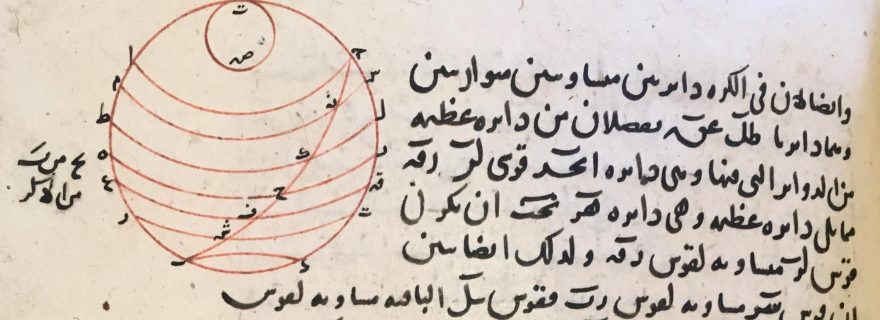An Arabic Astronomical Curriculum in the Leiden University Library
Medieval Muslim scholars are famed for their contributions to astronomical knowledge, but it is less clear how new students first learned to approach complex expert works like the Almagest. Part of the story may be found in the Middle Books of astronomy.
In August 2019 I attended the LUCIS Summer School on Philology and Manuscripts from the Muslim World to gain skills for approaching and analyzing Arabic manuscripts of varying provenances. I aimed to put those skills to use in studying the Middle Books (Kutub al-Mutawassiṭāt), several copies of which are in manuscripts of the Leiden University Library. The name of the Middle Books reflects their purpose: medieval Arabic sources tell us that these were the works to be read after Euclid’s Elements in preparation for Ptolemy’s more complex Almagest.
The 3rd/9th century translation movement brought a vast corpus of ancient Greek scientific texts into the Arabic language, and scholars in the Islamicate world found themselves studying works of sometimes significant complexity. Eleven of the texts which came to comprise the Middle Books were translated from Greek into Arabic during this movement. They provided scholars with much of the spherical geometry and astral knowledge needed to work with more advanced astronomical texts. The most comprehensive and influential edition of the Middle Books was produced by Naṣīr al-Dīn al-Ṭūsī in the 7th/13th century, but earlier versions of these works were collected and studied together long before his time.
During my time at the Summer School, I focused on the manuscript Leiden Or. 1031 (undated), a collection of three Middle Books texts in versions prior to al-Ṭūsī’s edition: al-Ṭulūʿ w-l-Ghurūb (Risings and Settings by Autolycus), Kitāb al-ʾUkar (Sphaerica by Theodosius), and Kitāb fī al-Ẓāhirāt (the Phaenomena by Euclid). Together they delve into spherical geometry and the movement of stars. These are rigorously structured texts: they present series of mathematical propositions which build upon each other over the course of the work. Each proposition is accompanied by a geometric diagram used for its proof.
As I delved into Leiden Or. 1031, I found it to be an excellent example of scholarly engagement with mathematical and astronomical texts. We can explore this through the names connected with the texts and through the marginalia (notes in the margins) which accompany them.
Several names appear beyond those of the texts’ original Greek authors. Their translators are identified as the 3rd/9th century Qusṭā b. Lūqā, Ḥunayn b. Isḥāq, and ʿAlī b. Yaḥya b. ʿIsa b. Yaḥya, respectively. More interestingly, in two of the colophons the scribe makes a point of declaring that the texts in question (the Sphaerica and the Phaenomena) were copied from exemplars in the hand of Najm al-Dīn b. al-Sarī, the 6th/12th century mathematician also known as Ibn al-Ṣalāḥ. This mathematician left his mark on the texts: several marginalia come from his comments.
One interesting example appears on folio 90a: Ibn al-Ṣalāḥ said the proposition’s figure was bad, and so another figure has been added in on a smaller paper attachment. There are several attachments like this in the manuscript, some clearly stating “This figure is correct.” Meanwhile, one colophon points to engagement outside the text: it states that two of the propositions are problematic and refers to responses to them in the works of the Greek Menelaus of Alexandria (1st century CE) and the Arabic Ibrāhīm b. Sinān b. Thābit (4th/10th century).
References to other texts also abound in the marginalia. In Risings and Settings and the Phaenomena there are multiple condensed comments that point the reader not just to an outside text, but to a specific proposition in that text. So a note such as “yāʾ bāʾ min al-Kurat al-Mutaḥarrika” on folio 76b provides a citation of “(proposition) 12 from the Moving Sphere (by Autolycus),” indicating that that proposition contains material relevant to what is presently being read.
The proposition and book numbers (where necessary) are given in abjad numerals, a system where numbers are represented by letters. So the letter bāʾindicates the number two, and the letter yāʾ the number ten. As the example above shows, these references are not limited to works contained in Leiden Or. 1031. They are, however, always pointing to other Middle Books texts, weaving interconnections between them. It is interesting to note that this seems to have been an ordered curriculum, and while this codex only presents evidence for three texts, in each case the citation is to a proposition which has occurred earlier in the curriculum’s supposed order.
Leiden Or. 1031 is only one of many copies of the Middle Books. As I continue my research, I will put it in dialogue with the curriculum’s other codices. The Middle Books were not static: the collection evolved as texts were studied and re-edited, and as additional texts were found to be useful and incorporated into the collection. Prompted by my study of Leiden Or. 1031, I have found similar scholarly notes and references attached to other Middle Books manuscripts. Taken together, these codices reveal the various scholars who engaged with the Middle Books over the centuries, as well as how these texts fit into a broader corpus of astronomical works. They grant us a rare insight into an advanced and specialized Arabic educational curriculum.



1 Comment
Hi
Yesterday I visited a manuscript in which Sheikh Baha'i (Shiite scholar) used the science of geometry to understand Shiite jurisprudence. Likewise, astronomy and engineering to understand religious sciences and, conversely, religious and intellectual sciences to understand engineering and astronomical sciences.